After reading many reviews on air quality monitors, I’ve become quite frustrated with the lack of what I would consider ‘quality’ reviews. While there are ample reviews of air quality monitors – especially those such as the AirVisual Pro or Airthings View Plus – very few seem to focus on the most critical aspects of these devices, such as accuracy.
Since I have extensive experience with air quality monitors after running this website for over four years, I decided it was time to write an article discussing my picks for the best. In this article, I will cover the best choices for each situation, no matter your budget or whether you want an indoor, outdoor, or portable air quality monitor.
Before we start, I want to clarify that I’ve only included devices on this list with which I have personal experience. I feel that it’s disingenuous to include any monitor that I haven’t personally used. For this reason, there are some notable exceptions from this list. Of course, I’ve purposefully excluded some monitors (such as the AirVisual Pro) because I don’t believe they deserve a place. However, some air quality monitors were excluded simply because I haven’t tried them yet.
Therefore, if you want to learn all the ins and outs of any given air quality monitor on this list, please refer to the full reviews which I have linked. While this article will compare many monitors and give a good overview, I have far more detailed information in the individual reviews, which you can peruse to find the perfect monitor for your needs.
It’s also worth noting that this list only contains consumer-grade air quality monitors that are < $300. While there are many more professional-grade monitors out there, these aren’t in the same market segment as the monitors on this list. Thankfully, we’ve seen many fantastic, low-cost monitors emerge over the past few years. Even better, many of these low-cost monitors perform very well and accurately.
While $15 monitors such as the IKEA Vindriktning aren’t yet monitors that I can recommend, it’s fantastic to see air quality monitoring becoming increasingly accessible. You’ll need to pay at least $50 to get an accurate monitor, but just a few years ago, you needed to pay at least a couple hundred. In a few years, I hope this price drops even further so that everyone has access to the tools needed to make decisions regarding air quality. With that said, let’s jump right in!
Subscribe to BreatheSafeAir
We spend 90% of our time indoors. Make sure the air you breathe indoors is healthy.
This post contains affiliate links. For more information, please refer to my affiliate disclaimer.
Information on this blog is for informational purposes only. Readers are encouraged to confirm the information herein with other sources. Furthermore, this information is not intended to replace medical advice from professionals. This website assumes no responsibility for the accuracy of the information, which is subject to change without notice.
Do I Need an Air Quality Monitor?

If you’re already aware of why an air quality monitor is such an important device, feel free to skip this section and continue below. However, if you’re just being introduced to such monitors, you may wonder why you even need one.
When it comes to the impacts of air pollution, it’s essential to differentiate between different pollutants. For example, fine and ultrafine particles such as PM2.5 and PM1 impact our health differently than volatile organic compounds (VOCs). Even carbon dioxide can have significant health impacts!
So, how does air pollution impact our health? Both outdoor and indoor air pollution can lead to various conditions, such as asthma, cardiovascular disease, allergic reactions, and more. It’s even been proven that poor air quality can decrease life expectancy!
However, poor air quality is far more insidious. Ultrafine particles have been found to decrease cognitive performance, cause (or at least worsen) depression, and, in the worst cases, potentially lead to suicide. Of course, these are the most severe impacts, and we aren’t likely to experience these outcomes.
What is more worrying and more applicable to most people reading this article is the short-term impact of air pollution. High concentrations of fine dust and carbon dioxide have decreased cognitive performance and cause drowsiness. On the other hand, VOCs can easily lead to headaches, nausea, and loss of coordination.
Whether outdoors or indoors, air pollution can impact you physically and mentally. Therefore, keeping track of pollutants and knowing what we are breathing at any given time is highly beneficial. Although air quality monitors aren’t perfect, they are the best tools we currently have available to keep an eye on local air quality levels.
Features to Look For in an Air Quality Monitor
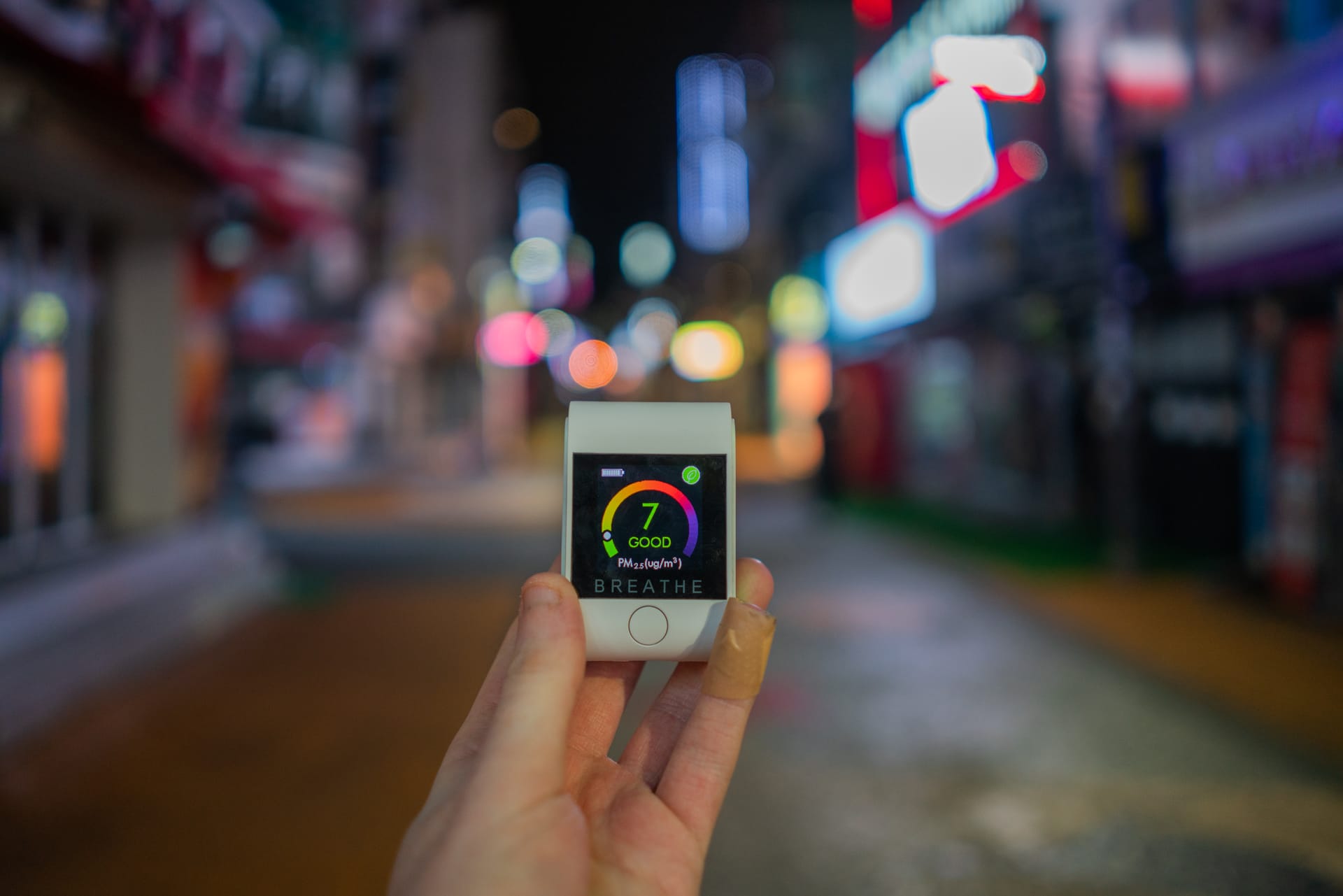
Trying to find the best air quality monitor can feel overwhelming. However, while there are many options, few likely have the exact features you’re looking for on such a monitor. Knowing what to look for makes choosing the perfect monitor significantly easier. Below is my list of the minor ‘nice to have’ features I am looking for, followed by the most important features.
Nice to have features:
- Updateable (with regular updates)
- Compact size
- Configurable alarm/threshold notifications
- Rechargeable battery
- Type-C USB connection
- Data sharing
- Data logging
- Data exporting
1. Essential Sensors

Pollution sensors on the uHoo air quality monitor
The first and most important consideration you’ll want to make when purchasing an air quality monitor is what types of sensors you need. Nearly every air quality monitor will have a PM2.5 sensor, but everything else will depend on the monitor in question.
So, how do you decide what sensors are essential? Well, I hate to say this, but it depends. If you are only interested in monitoring particulate pollution, you’ll want to look for a monitor with any combination of PM1, PM2.5 and PM10 sensors.
However, if you’re looking for a complete indoor air pollution monitor, you’ll want a VOC sensor, as VOCs pose a much bigger health threat indoors than outdoors. A carbon dioxide sensor on an indoor air pollution monitor can also be invaluable!
If you feel emergency alerts are essential, a carbon monoxide sensor is also a big help. Although I’ve never had to use one before, I appreciate having one included on air quality monitors, as it feels reassuring to have one.
Again, while it depends on your use case, here are my recommendations:
| Air Quality Monitor Type | Essential Sensors | Optional Sensors |
|---|---|---|
| Outdoor | PM1.0, PM2.5, PM10 | PM1, NO2, O3 |
| Indoor | PM2.5, VOC | PM1, PM10, CO2, CO |
2. Good Accuracy
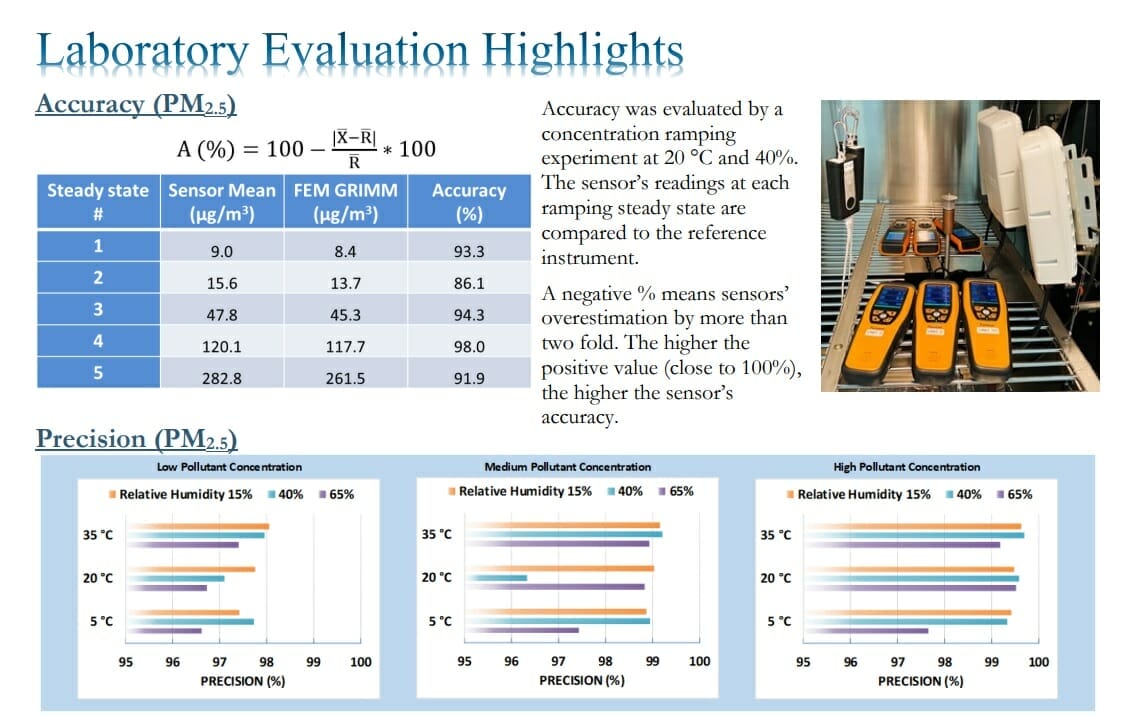
AQ-SPEC by South Coast AQMD accuracy report for Atmotube PRO
It’s important to do your own research whenever you can. In the case of air quality monitors, this means ensuring the sensors in your device are accurate and trustworthy. Unfortunately, finding this information isn’t always easy, as many devices lack third-party testing.
So, how can you check whether the device you are interested in is accurate? Since it can be hard to find official specifications, the best thing to do is check reviews from unaffiliated websites. Some websites, such as Smart Air Filters, conduct tests on air pollution monitors and compare them to reference monitors.
While Smart Air does sell many monitors, it’s a great resource and a certified B Corp. I’ve referenced its reviews and tests on many occasions, and I can confidently recommend checking its website for reviews (and accuracy tests) before purchasing any monitor.
It’s also essential to check for official accuracy testing. While not every monitor has such testing or will advertise it, some air quality monitors, such as Atmotube PRO, have undergone testing by organisations such as South Coast AQMD. AQMD has also conducted tests on various other monitors, and I recommend checking its database before purchasing a monitor.
If you can’t find either of these, I recommend checking the spec sheet for the air quality monitor and looking for the individual sensor components used. Often, these will be from large sensor companies such as Senirion or Senseair. The accuracy of these components is often well-documented, and you should be able to find information on review sites and forums.
At the end of the day, the most important aspect of any air quality monitor is its accuracy. If a monitor isn’t accurate, it can’t give you insights into your local air quality. Generally, accuracy within the below brackets is expected in this price range:
| Sensor Type | Expected Accuracy |
|---|---|
| PM1, PM2.5, PM10 | ± 10-20% |
| VOC | ± 25% |
| CO2 | ± 5% (± 30 ppm AND 5%) |
| Temperature | ± 0.5°C |
| Relative Humidity | ± 3% |
| Air Pressure | ± 1 mBar |
3. Internal Battery & Battery Life

If you’re looking for a portable air quality monitor, having a long-lasting battery is a top priority. While there are a lot of portable air quality monitors out there, many only have an eight to 24-hour battery life. This can make them very frustrating to use on the go as they must be charged daily.
Battery life is almost single-handily the reason I can recommend the Atmotube PRO so easily. While I prefer the app and usability of other portable devices, nothing comes close to the convenience of picking up the device every morning without worrying about battery life (provided you charge it once per week!).
Of course, battery life is far less important or irrelevant if you’re looking for a static air quality monitor. For example, if you want to place a monitor in your lounge, there’s no need to pay extra for a device with a battery.
Devices with short battery life, such as the Qingping Air Monitor Lite, can also be handy. Although the battery will only last eight hours, it’s handy to quickly check the air quality in other rooms without carrying around an adapter and USB cable. Of course, as a portable monitor, eight hours isn’t enough for me to warrant using it.
So, ask yourself: What’s the purpose of the air quality monitor you are purchasing? Is it intended for use in a home or office, or do you want to be able to take it out and about with you?
4. Wireless Connectivity


Qingping app (from the Qingping Air Monitor and Air Monitor Lite)
When deciding what air quality monitor to purchase, it’s essential to consider connectivity options. Are you content with a non-connected monitor? Or do you deem a monitor with a Bluetooth or WiFi connection essential? Furthermore, are you looking for a monitor with HomeKit, Alexa, or IFTTT integration? These are all things to consider when selecting the ideal monitor.
Every monitor on the list today has connectivity in some form, and once you spend over $80, you’ll find the vast majority of monitors offer a connection of some kind. For portable monitors, this is usually Bluetooth, and for indoor air quality monitors, it’s more often WiFi.
Most monitors will offer connectivity through the company apps. While this is useful, I prefer monitors with integration into some smart home systems. Since I use an iPhone, Homekit integration is a big deal for me as it allows me to automate many functions easily.
For example, turning my air purifier on automatically when the PM2.5 concentration exceeds my threshold is incredibly useful. The same goes for my dehumidifier and humidity. However, not everyone is interested in these features, and in those cases, a standalone device or app-only connection might suffice.
Regardless of what kind of device you choose, you will want to ensure it can retain some data. It’s too easy to lose a Bluetooth or WiFi connection temporarily; in these cases, having a device that can retain some data is invaluable.
5. Indicators & Alarms
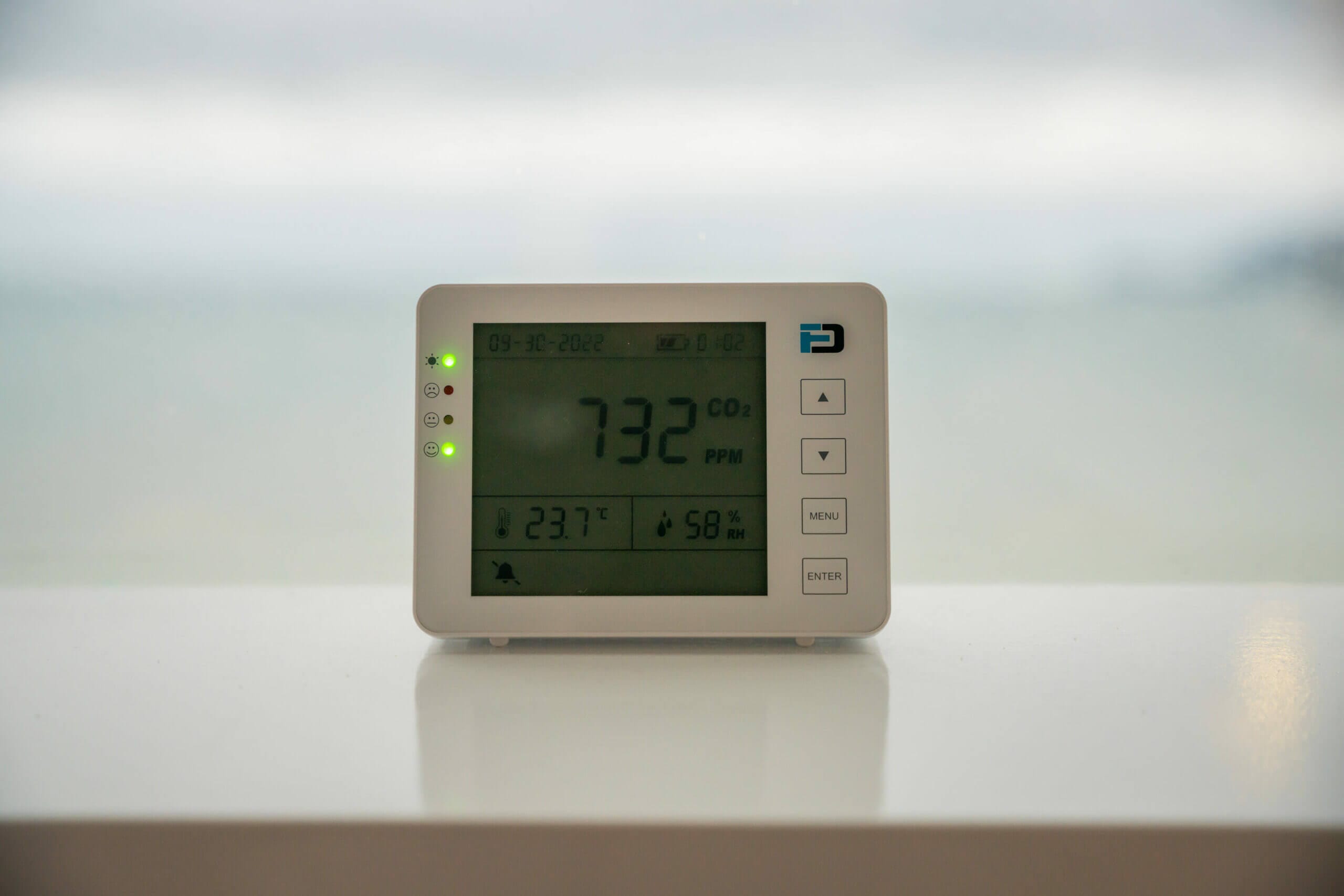
The Forensics Detectors CO2 Monitor is a great example of a monitor with good notifications.
An air quality monitor’s job is to inform you about the air you breathe. However, unless you constantly check the app or device’s screen, it’s hard to know exactly when the air you’re breathing is beginning to become dangerous.
For this reason, it’s important to check if an air quality monitor can indicate or notify you when pollutant concentrations become harmful. Depending on the monitor, this indication will vary – it may be a flashing light, a beep, or a notification on your phone.
At the end of the day, all that’s important is that your monitor or phone can notify you when necessary. This feature is even more important if your air quality monitor supports carbon monoxide monitoring.
6. Manual Sensor Calibration
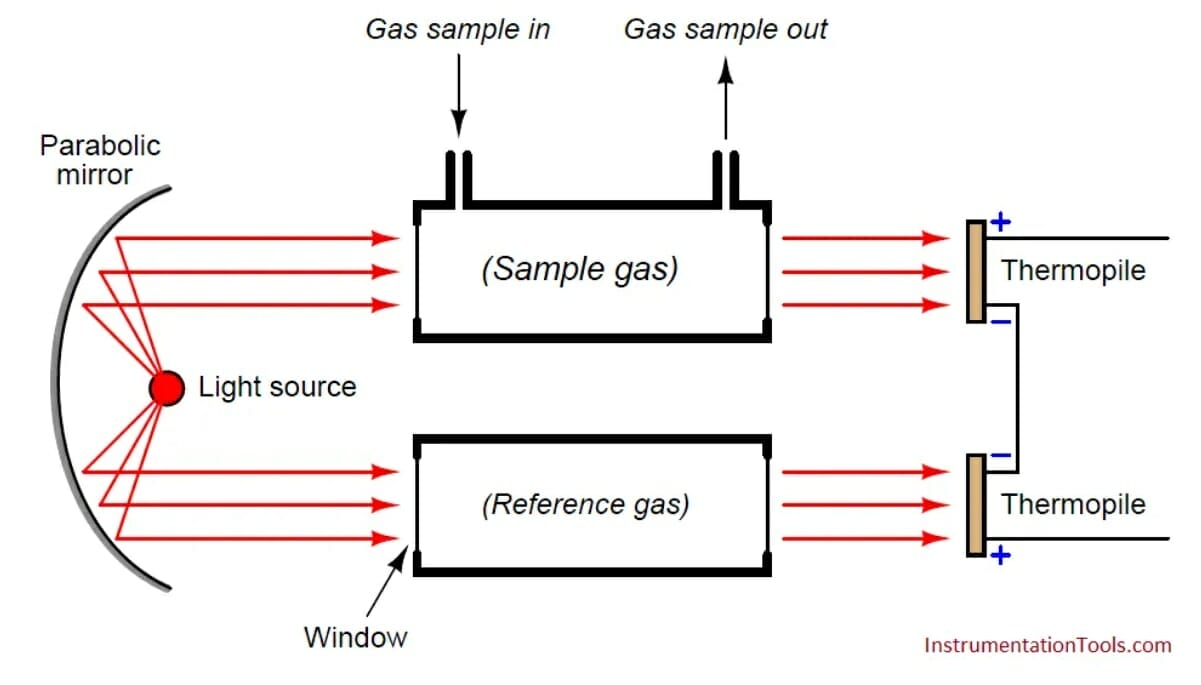
Dual-beam NDIR CO2 sensor diagram. Source: Instrumentationtools.com
Over time, sensors tend to drift and lose accuracy. While this isn’t an issue in the short term (unless your device comes incorrectly calibrated), it can cause air quality monitors to show wildly incorrect measurements after a few months or years of usage.
Sensor drift impacts all sensors, but VOC and CO2 sensors tend to be the most affected. As such, it’s important to ensure the device you purchase features a recalibration method if the air quality monitor features either of these sensors.
Many manufacturers advertise auto-calibration as a ‘feature’. However, it can be detrimental to performance and can lead to incorrect readings over time. As such, you should check for air quality monitors that allow you to calibrate their sensors manually.
Typically, calibrating a VOC or CO2 sensor is a quick process involving taking your air quality monitor outside for a few minutes. This will allow the sensor to judge what clean air is and will allow the monitor to set a new baseline on which to base concentrations in the future.
Best Air Quality Monitors

There are many air quality monitors out there, and picking the best wasn’t easy. However, my general recommendations can be found in the table below. If you’re interested in reading why I made each suggestion and to whom I recommend each air quality monitor, please read on!
| Air Quality Monitor | Indoor/Outdoor | Sensors | Connectivity | Price |
|---|---|---|---|---|
| uHoo | Indoor | PM2.5, CO2, NO2, CO, VOC, temp, RH, air pressure | App, Alex, Assistant, IFTTT | $299 |
| Qingping AM | Indoor | PM2.5, CO2, VOC, temp, RH | App, Mi Home | $130 |
| Qingping AM Lite | Indoor | PM2.5, CO2, PM10, temp, RH | App, HomeKit, Mi Home | $90 |
| Atmotube PRO | Portable | PM1, PM2.5, PM10, VOC, temp, RH, air pressure | App | $179 |
| IKEA Vindstyrka | Indoor | PM2.5, VOC, temp, RH | Zigbee | $49.99 |
| AirGradient ONE | Indoor | PM1, PM2.5, PM10, CO2, VOC, NOx, temp, RH | Web dashboard | $138 or $195 (DIY or fully-assembled) |
| AirGradient Open Air | Outdoor | PM1, PM2.5, PM10, CO2, VOC, NOx, temp, RH | Web dashboard | $95 – $190 depending on model |
| Airthings View Plus | Indoor | PM1, PM2.5, CO2, VOC, temp, RH | App, Web dashboard, Smarthome integrations | $299 |
Best All-Round Air Quality Monitor
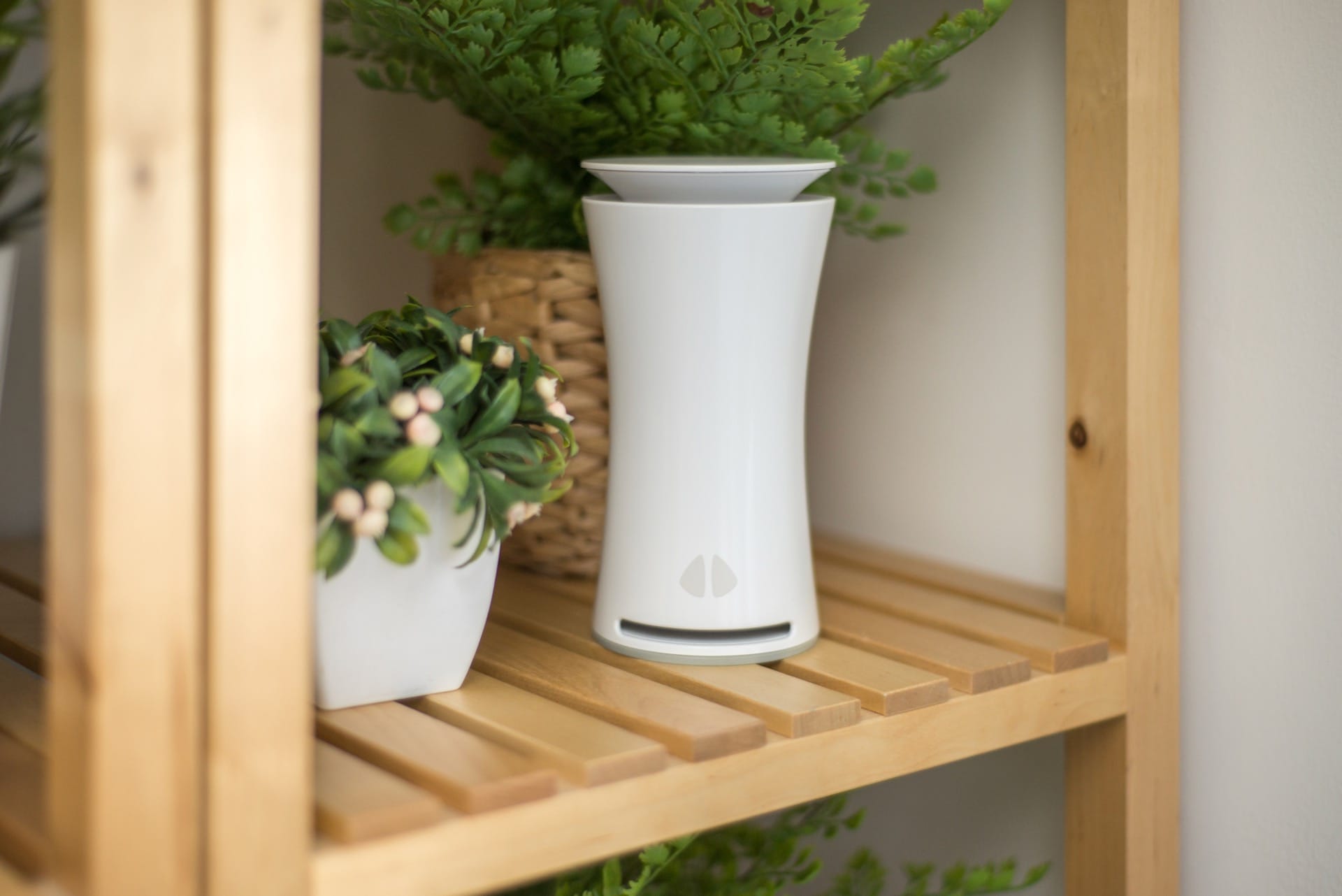
Pollution Sensors: PM2.5, VOC, CO2, NO2, CO, O3
Battery Life: N/A
Connectivity: uHoo app, Alexa, Google Assistant, IFTTT and more
Price: $299
Other Sensors: Relative humidity, temperature, air pressure
Connection Type: Micro USB
If money isn’t an issue, the uHoo air quality monitor is the best all-around monitor and one that I can easily recommend. I’ve used my uHoo for over two years, and it’s still my go-to indoor air quality monitor. Why? because it provides a wealth of information.
I do have to make a disclaimer here. While I love the uHoo air quality monitor, uHoo recently launched a paid subscription service called uHoo Premium. I haven’t yet tried this feature because while it looks to provide an even greater wealth of information, I can’t justify $10 per month when the app already provides all the data I need. I wanted to mention this new service because I’m not a fan of this new direction. Just keep in mind the subscription is not essential!
So, what makes uHoo such a solid option? Its extensive range of sensors! On uHoo, you will find no less than nine individual sensors that monitor temperature, humidity, air pressure, carbon dioxide, VOC, PM2.5, carbon monoxide, nitrogen dioxide, and ozone. While you are paying a steeper price, there are very few monitors with such an extensive array of sensors.
Since there is so much data the uHoo can provide, the manufacturers decided to allow users to interact with the device only through an accompanying app or smart home integration. Considering the vast amount of information a relatively small screen would have to convey, I agree with this decision.
Unfortunately, uHoo’s smart home integration is not great. While it supports Google Assistant, Alexa, and IFTTT, the integration feels half-hearted, and I found that sometimes I wouldn’t get a response. This was frustrating, and I resorted to using the app and forgetting these integrations.
While the app is slow, I find it useable as it’s straightforward and easy to use. Furthermore, the app does a good job of graphing indoor air quality and showing trends over time. The graphs are easily clear and convey all the essential information. While I wish the app could be sped up, this isn’t a dealbreaker for me.
Regarding the sensors, uHoo is not obviously missing anything. Its particulate, VOC, and CO2 sensors mean this device covers all bases. However, uHoo goes a step further by being one of the only indoor air quality monitors on this list to monitor carbon monoxide and ozone!
The best part about this device is the app is highly customizable. You can set thresholds for the device to send notifications (for me, I turned notifications off, except in the case of carbon monoxide), which is extremely handy!
If you’re looking for an all-in-one air quality monitor, uHoo is your best bet. While it is pricey, cheaper alternatives generally don’t share the same range of sensors and will remove the CO, ozone, and NO2 sensors instead. Therefore, while the price is steep, I could justify it for these additional features.
Is it flawless? No. I would love to see an update to USB Type-C, a faster app, and an update to 5ghz WiFi. However, even with these flaws, I see the uHoo as an extremely solid indoor air quality monitor and one you might want to check out.
Best Open-Source Air Quality Monitor

Pollution Sensors: PM1.0, PM2.5, PM10, CO2, VOC, NOx
Battery Life: N/A
Connectivity: Web dashboard. It can be integrated into many smart home systems with coding knowledge.
Price: $138 or $195 (DIY or fully assembled)
Other Sensors: Relative humidity, temperature
Connection Type: USB Type-C
The AirGradient ONE air quality monitor is unique for several reasons. Firstly, it’s the only open-source air quality monitor on this list – regarding hardware and software. This means that while you can use it as it ships, you can modify it however you see fit. Since it’s open source, you can even implement the monitor into a range of smart home ecosystems with some technical knowledge.
On top of this, the monitor can be purchased either as a DIY kit (which doesn’t require soldering) or fully assembled. Both options have advantages, and I love choosing which kit I would prefer to purchase. The DIY kit is $60 cheaper if you want to save money. However, if you buy the monitor already assembled, it will come with a range of certifications, a 12-month warranty, and a lab report from AirGradient that shows the accuracy of the monitor.
Whether you choose the DIY or fully assembled monitor, both can be opened and repaired quickly and easily. If you ever have an issue with an individual component, you can easily replace it with a new sensor from AirGradient or your local electronics supplier. This means that the AirGradient ONE is made to last, and it should be repairable for many years.
Another advantage of the AirGradient ONE is that the components used are high-quality and from trusted manufacturers. The particle sensor is a Plantower PMS5003, which has appeared in ample studies and research papers. For CO2, VOCs, and NOx, sensors from the trusted companies Senseair and Sensirion are used. Considering the price (especially for the DIY monitor), the AirGradient ONE has some of the most accurate sensors in this price range.
While the AirGradient ONE can be integrated into various smart home networks with some technical know-how, it also comes with a web dashboard for anyone who doesn’t want to tinker with their device. The air quality monitor will connect to WiFi and upload its data to a web dashboard, which can be accessed from anywhere with an Internet connection. If you use other AirGradient monitors, such as the outdoor Open Air, or monitors from other companies, such as IQAir, AirThings and Atmo, you can also see the data from these monitors on this dashboard.
Design-wise, the AirGradient ONE has a small OLED screen that provides updates on pollutants in your home or office. While the screen is small, it’s very viewable even from a distance. However, to give you even quicker insights into your air quality, a row of LEDs at the top of the device can show particle or CO2 levels based on user-adjustable thresholds.
Best User-Friendly Air Quality Monitor

Pollution Sensors: PM1.0, PM2.5, CO2, VOC, radon
Battery Life: Up to 2 years
Connectivity: Web dashboard and app
Price: $299
Other Sensors: Relative humidity, temperature, air pressure
Connection Type: USB Type-C
If you’re looking for a simple, user-friendly monitor, the Airthings View Plus and Wave Plus are two monitors worth considering. However, due to the extra sensors of the View Plus, I’ve chosen to opt for that monitor in this section instead. Now, while I believe this is a great, simple-to-use monitor, it’s not for anyone wanting advanced features, as I’ve discussed in more detail in my full review.
So, what makes this monitor so great for anyone looking for an easy way to monitor their air quality? Well, Airthings has equipped the View Plus with a wide range of sensors while keeping the device incredibly easy to use. Not only is the device itself minimalistic (especially seeing as it can only display two pollutants at once) but the app and web dashboard are very intuitive. However, there are a few caveats, and this air quality monitor lacks more advanced functionality, such as user-adjustable thresholds, manual calibration, and more.
If you don’t need these features, or if you’re looking to recommend an air quality monitor for a friend or family member who wants something straightforward to use, the Airthings View Plus is a good monitor with high accuracy. While it does use some lower-quality sensors (which I wish were better at this price), they have proven accurate in my own testing, and I am confident about the readings this monitor produces.
Perhaps the most unique aspect of the View Plus is that it can be powered via a Type-C cable or six double A batteries. While having a battery isn’t unique in itself, what is special here is the incredible (up to) two-year battery life this device manages. While it will only upload data to the web dashboard every ten minutes, not needing to worry about batteries is a nice peace of mind.
This air quality monitor uploads data via WiFi to either the app or web dashboard, meaning you can easily view historical trends and change device settings. This is nice but also essential, as the device only shows two pollutants at once and has no physical buttons.
Overall, the Airthings View Plus is a solid monitor for anyone who prioritises ease of use over advanced functionality. If you are in the latter group, you will be far better matched with a monitor such as the significantly cheaper AirGradient ONE, which supports far more advanced features.
Best Desk-Based Air Quality Monitor
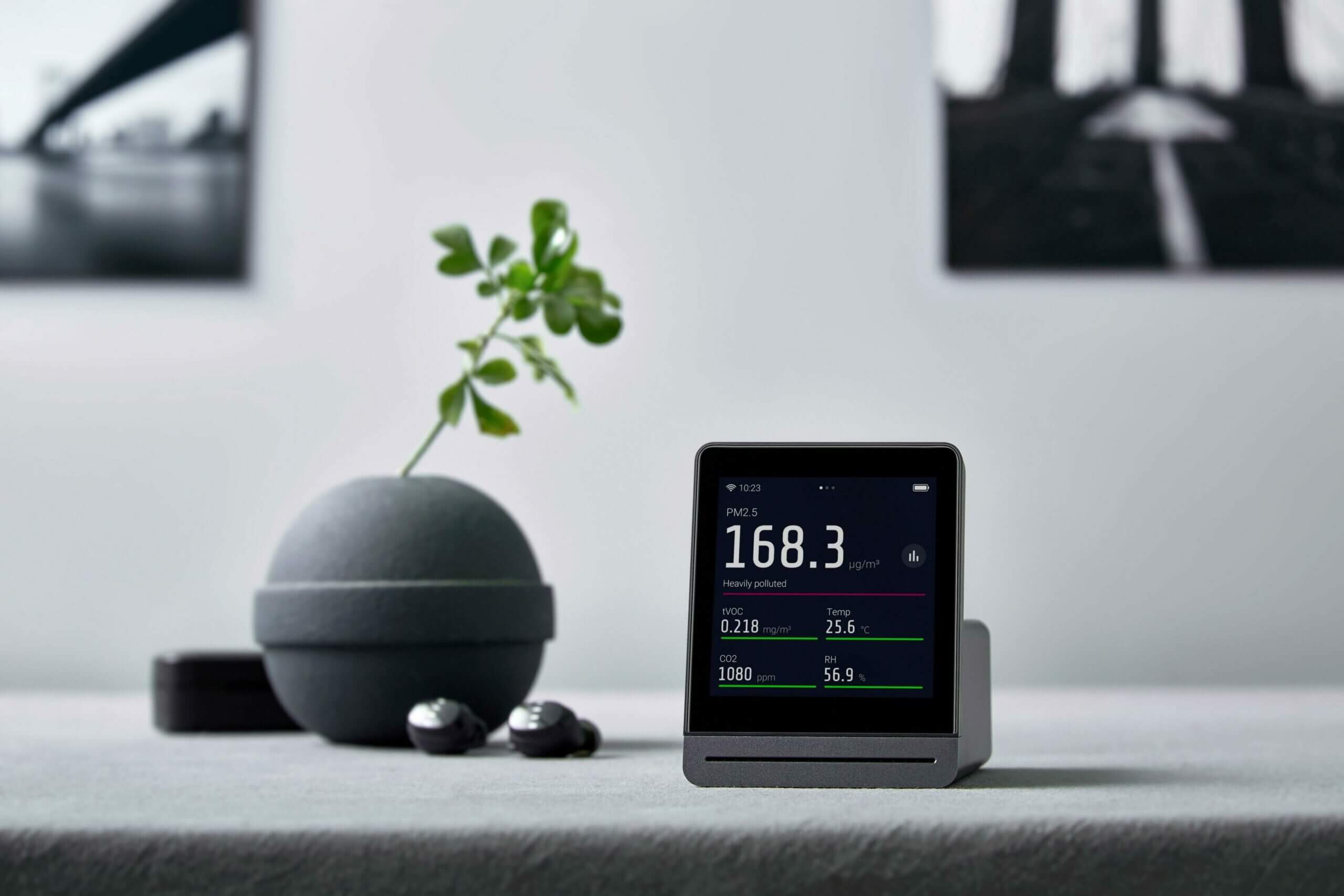
Pollution Sensors: PM2.5, VOC, CO2
Battery Life: Up to 7 hours
Connectivity: Qingping+ App, Mi Home
Price: $130
Other Sensors: Relative humidity, temperature
Connection Type: USB Type-C
If you’re looking for an air quality monitor perfect for your desk, bookshelf, or windowsill, the Qingping Air Monitor is the device you’ll want to check out. It has connectivity via the Qingping+ app and a high-quality (albeit small) screen detailing your current air quality.
Inside the Qingping Air Monitor, you’ll find carbon dioxide, PM2.5, VOC, temperature and relative humidity sensors. While I would love to see a PM10 sensor added (which is coincidentally included in the smaller, more affordable Qingping Air Monitor Lite), the Qingping Air Monitor has a solid range of sensors.
The device has a battery and USB Type-C charging port alongside these sensors. Unfortunately, the device’s battery life is quite minimal, at around seven hours, meaning you’ll want to keep it plugged in the vast majority of the time. Thankfully, the connection is the modern Type-C.
With this short battery life (and the rather inconvenient shape for pocket/backpack carrying), the Qingping Air Monitor is clearly meant to be a desk-bound monitor, and I would not recommend using it on the go. That said, it’s nice to see a battery included, as the monitor can be moved around a home or office without powering off.
Thankfully, the Qingping product excels as a static monitor. Surprisingly, for such an affordable device, the Qingping Air Monitor has a high-quality, high-resolution touch screen. Not only does it look great, but the screen is very responsive – which impressed me greatly!
Depending on how you’ve set your device up, the home screen will provide an overview of the local air quality with all readings provided. While the screen can feel cluttered at times due to the overwhelming amount of information, there is no denying that the device provides detailed insights into your indoor air quality.
If you prefer to interact with the Qingping Air Monitor via your smartphone, you can do so via the Qingping+ app. The app is fluid and fast, making it one of the best air quality monitor apps I’ve tried to date. The app provides graphs for each sensor and allows the user to identify trends in their indoor air quality.
Whether you use the device by itself or with the connected app, the Qingping Air Monitor is a solid, all-around air quality monitor. However, what makes it so compelling is its very reasonable price, which makes many more expensive monitors much less tempting.
Best Small Air Quality Monitor
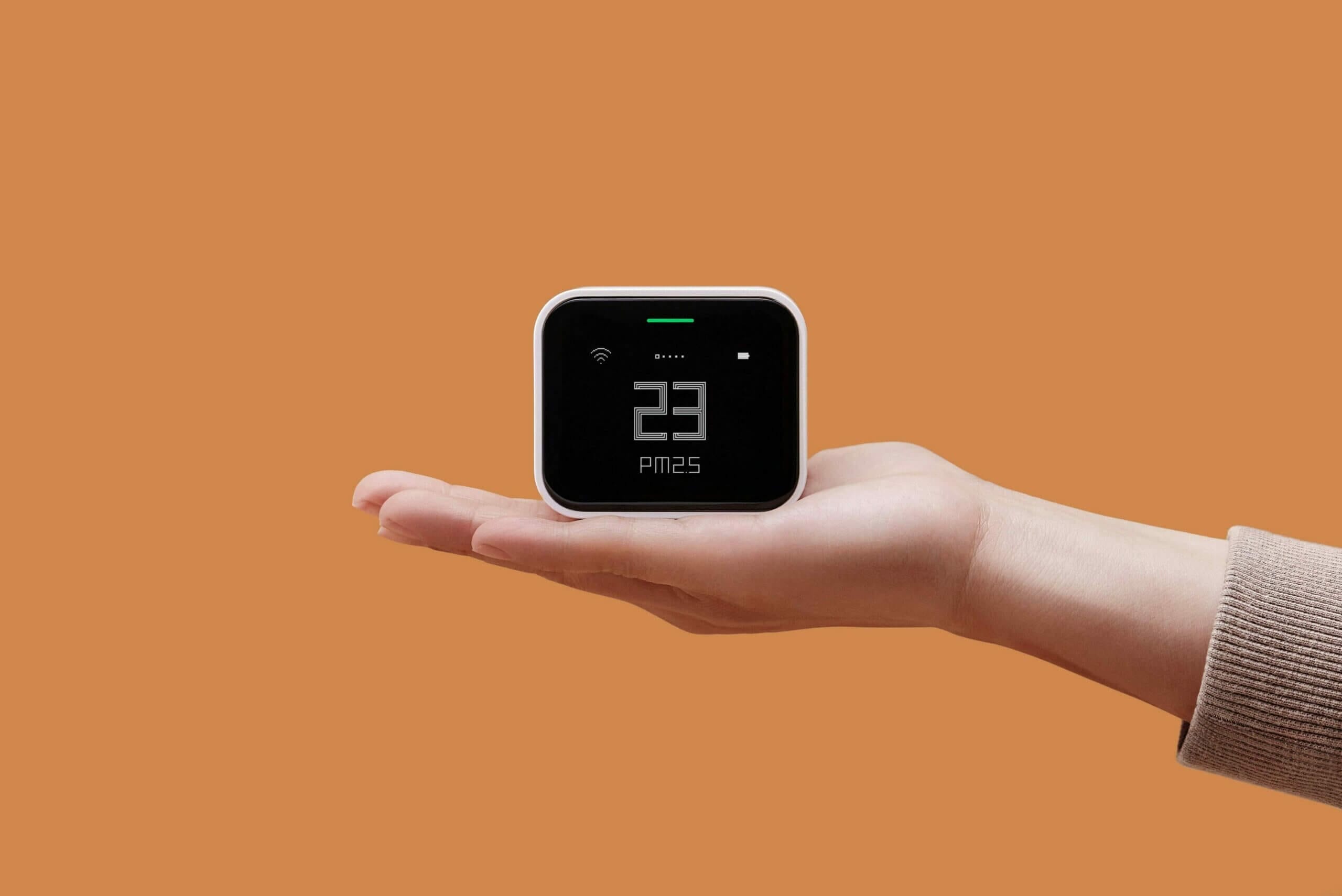
Pollution Sensors: PM2.5, PM10, CO2
Battery Life: Up to 8 hours (can be expanded if sleeping)
Connectivity: Qingping+ App, Mi Home, Apple HomeKit
Price: $90
Other Sensors: Relative humidity, temperature
Connection Type: USB Type-C
If you want an air quality monitor that takes up almost no room in your home, you’ll want to check out the Qingping Air Monitor’s smaller sibling – the Qingping Air Monitor Lite. While the names are almost the same, these devices differ so greatly that they feel like they are from different companies! If I’m honest, the only similarities between the devices are their great build qualities and surprisingly affordable prices.
The Qingping Air Monitor Lite is a small cube of 2.5 x 1.8 x 2.2 inches. In other words, it’s a very small device that can easily slide into your backpack or pocket (although it isn’t a great portable monitor! More on that soon). With such a compact size, this is the best air quality monitor if you want something unobtrusive.
The Qingping Air Monitor Lite houses a PM2.5, PM10, CO2, relative humidity and temperature sensor. While the device lacks a VOC sensor, I can forgive this at the affordable price. However, if you deem a VOC sensor essential, you’ll want to move to the Qingping Air Monitor or another indoor air quality monitor.
While this air quality monitor does have a screen, the screen is quite small and only displays one measurement at a time. To get a full overview of your indoor air quality, you’ll need to use the touch bar on top of the device to scroll through every reading. While this isn’t a big deal, it isn’t as convenient as devices with larger screens capable of displaying every reading at a glance.
Instead of using the screen, I recommend using the Qingping+ app or HomeKit instead. The Qingping+ app is a fast and fluid app that provides graphs for each pollutant. This is fantastic if you want to identify trends in your indoor air quality. If you prefer to integrate the monitor into your smart home, you can do so with HomeKit or Mi Home.
Unfortunately, the smart home integration feels half-hearted – at least on HomeKit. The functions are limited, and I would highly recommend using the Qingping+ app instead, as it offers a far more detailed view of your indoor air quality and provides a range of settings that can’t be found on the device itself.
The Qingping Air Monitor Lite is powered by a USB Type-C cable which connects to the back of the device. While a battery is built into the device, the battery life is minimal, at around eight hours. Furthermore, the device puts itself to sleep after a few minutes, making it a poor choice as a portable air quality monitor.
That said, I appreciate the device’s battery life of a few hours. If the power goes out temporarily, the device will stay on and not need to be reset when the power returns. In addition, you can temporarily move the device to another room for air quality testing without needing a cable and power socket.
If you’re looking for a small air quality monitor, the Qingping Air Monitor Lite is a great choice. With great connectivity, this device is also a great choice if you want to hide it and access data by the app alone.
Best Portable Air Quality Monitor
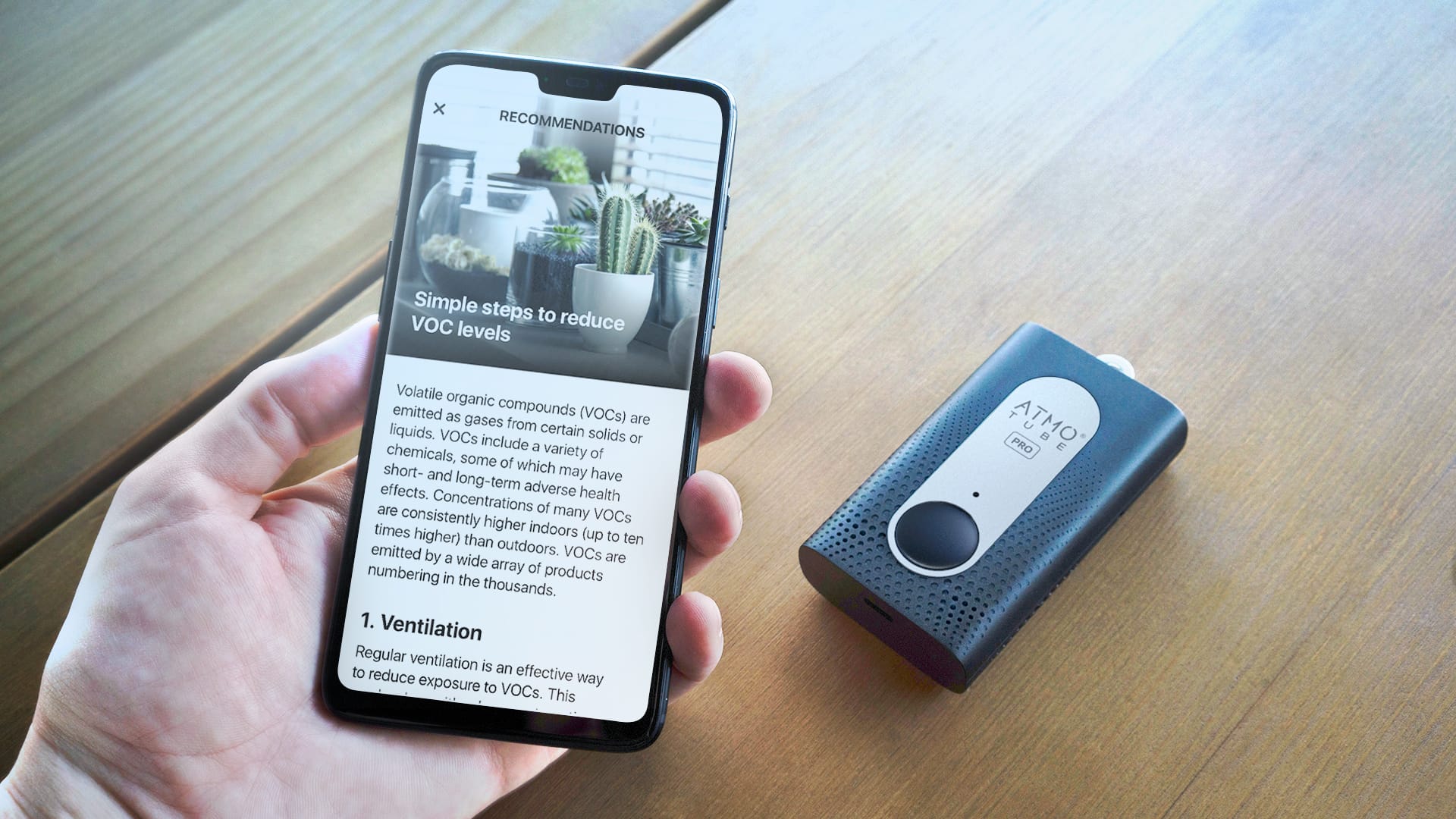
Pollution Sensors: PM1, PM2.5, PM10, VOC
Battery Life: Up to one week
Connectivity: Atmotube app
Price: $179
Other Sensors: Relative humidity, temperature, atmospheric pressure
Connection Type: USB Type-C
Although I’ve reviewed a range of portable air quality monitors, including the Flow 2 and Breathe Smart 2, I have no doubt about which I would recommend. The device I would recommend so easily is the Atmotube PRO.
Why do I recommend this over the other two? Well, in my Flow 2 vs. Atmotube PRO comparison, it largely came down to one key factor – battery life. The Flow 2 needs to be charged daily, but the Atmotube can last for a week. On top of this, this portable air quality monitor offers a far better selection of sensors than the Breathe Smart 2 and Flow 2.
For this reason, it’s easy to say the Atmotube PRO is a well-rounded air quality monitor with all the basics and more. It provides connectivity via an iOS or Android app, has great battery life, and has a great variety of sensors to keep you up to date on your local air quality.
Atmotube PRO will track PM1, PM2.5, PM10, VOC, atmospheric pressure, humidity, temperature, and altitude. Compared to the current portable air quality monitor alternatives, nothing offers the same fantastic range of sensors as this device from Atmo.
Furthermore, in third-party testing, the particulate matter sensors have proven accurate enough to be trusted. While they aren’t totally accurate compared to reference monitors, they have a margin of error of 10%, meaning you can trust the readings your Atmotube is providing you.
Besides the battery life, the connectivity and included carabiner make the Atmotube PRO the perfect portable air quality monitor. While the device’s build doesn’t feel particularly high quality (mostly plastic, with only the carabiner being metal), it feels durable enough to join you on various journeys. Of course, you’ll need to be careful around water as the Atmotube is not waterproof or even resistant.
The Atmotube PRO is not perfect, and I’m not a big fan of the app. When opening the app, you’ll need to wait a few seconds to sync data from your device, and if you haven’t opened the app in a while, this process can take a while. On top of this, the UI could be vastly improved, as while graphs are currently provided, they can be confusing.
However, despite these flaws, I still use the Atmotube PRO as my portable air quality monitor. It doesn’t suffer from poor battery life like devices such as the Flow 2, and the range of sensors makes it more useful than devices such as the Breathe Smart 2.
While the Atmotube PRO isn’t cheap, it has a competitive price considering the technology packed within. It’s more affordable than many less-equipped monitors (including many desk-based and wall-mounted air quality monitors) and has no major downsides.
Overall, the only addition I would like to see on the Atmotube PRO is a carbon dioxide sensor. Currently, I still need to rely on a portable carbon dioxide monitor such as the Aranet4 for this purpose. If Atmo could include a carbon dioxide sensor, it would truly be the only portable device I need!
Best Affordable Air Quality Monitor
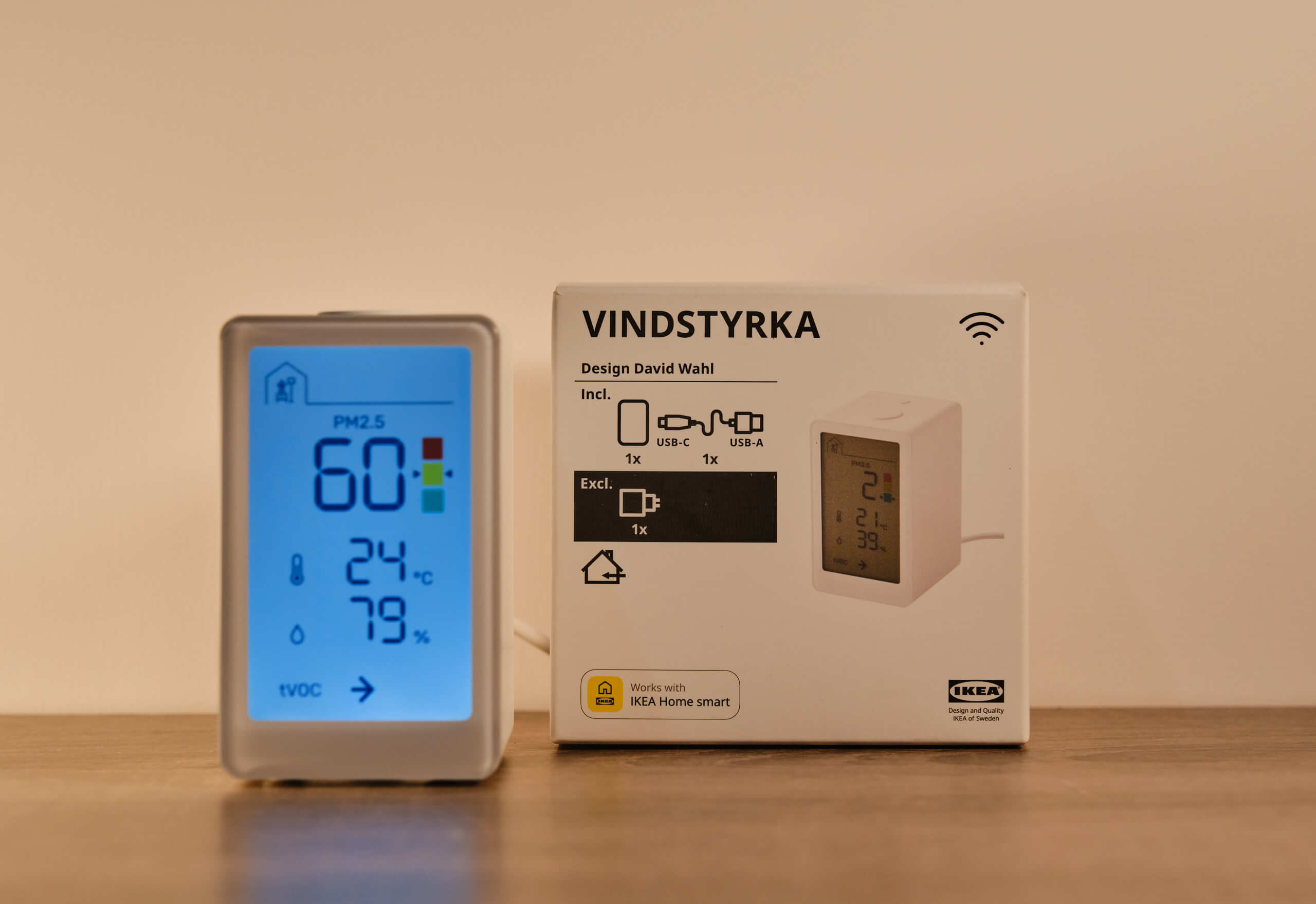
Pollution Sensors: PM2.5, VOC
Battery Life: N/A
Connectivity: Zigbee (requires DIRIGERA Hub)
Price: $49
Other Sensors: Relative humidity, temperature
Connection Type: USB Type-C
IKEA has launched two inexpensive air quality monitors over the past few years. While the cheaper device (the Vindriktning) comes in at only $15, it’s also too inaccurate to be considered a good inexpensive option. Luckily, its $49 sibling is still a very affordable device.
The Vindstyrka is a simple air quality monitor that monitors PM2.5, VOCs, temperature, and relative humidity. All of these are measured with a fantastic Sensirion SEN54 sensor – a sensor that alone costs more than half what the Vindstyrka does. This fantastic sensor in an inexpensive package makes this IKEA air quality monitor such a good offer.
There are some issues with this monitor, which I want to get out of the way first. Firstly, it requires an IKEA DIRIGERA Hub to have connectivity. While there are some workarounds, they are technical and will require extra steps. Through these workarounds, I’ve seen the monitor working with a range of smart home platforms.
Secondly, this monitor will only show you qualitative values for VOCs – either increasing, stable, or decreasing. This can be handy, but it’s nowhere near as useful as quickly glancing at the device and getting a specific VOC value. Unfortunately, you also can’t access VOC information through any integration.
These are frustrating caveats, but on the bright side, this is a very inexpensive indoor air quality monitor with incredible accuracy – both for the price and overall. In this price range, no other monitor is as accurate as the Vindstyrka. While the Amazon air quality monitor is another inexpensive option, I haven’t yet had the chance to test it.
This IKEA monitor has no internal battery and must be powered at all times. This can be done by a USB Type C port at the bottom of the device. While it would be handy to have even a small battery (that could cover power outages and allow you to test the air quality in other rooms easily), at this price, I feel like I can’t complain.
The device’s design is simple and follows a minimal but contemporary design language. I appreciate this approach, though, as it’s easy to put the Vindstyrka almost anywhere in your house and have it blend in. While it won’t catch anyone’s attention, this is probably for the better.
If you’re looking for an affordable air quality monitor, the IKEA Vindstryka is an amazing value proposition. It has flaws, but that’s to be expected at this price. What it does have, however, is a very accurate sensor that makes this device worth its price.
Best Outdoor Air Quality Monitor
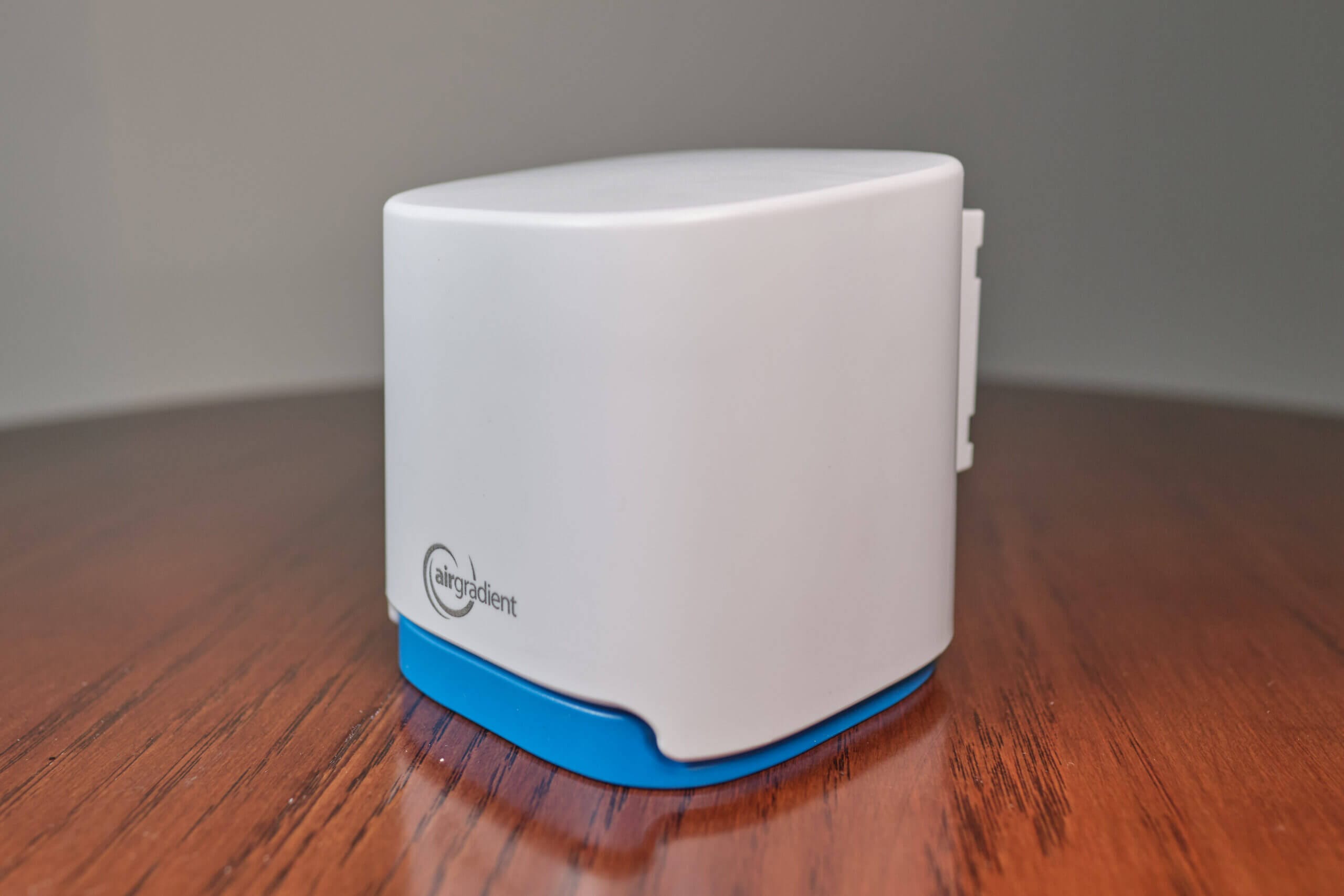
Pollution Sensors: PM1, PM2.5, PM10. Some models also support VOC, CO2 and NOx.
Battery Life: N/A
Connectivity: Web dashboard
Price: $95 – $190 (different models available)
Other Sensors: Relative humidity, temperature
Connection Type: USB Type-C
If you’re looking for an inexpensive yet accurate outdoor air quality monitor, the AirGradient Open Air should be one of the first monitors you consider. This monitor is available in a range of configurations (supporting different sensor configurations and being available in a discounted DIY kit), is fully open source, and has user-replaceable parts.
However, I recommend the AirGradient Open Air as an outdoor air quality monitor only partly because of these reasons. The primary reason I choose to recommend this device is that you can contribute to community-driven air quality maps such as OpenAQ. Many outdoor air quality monitors tie the user into their platform, and in that way, they commercialise the data generated by users.
These maps provide an invaluable resource to people in areas where government monitors aren’t present. Furthermore, since air pollution can be very localised, every monitor added to networks such as OpenAQ means more accuracy. Of course, if you don’t want to contribute to these platforms, you can keep the data from your monitor private by disabling the ‘public’ option.
The AirGradient Open Air is available in a few configurations with different sensors. However, whichever monitor you decide suits your needs best, you can rest assured knowing you are getting a monitor with high-quality and accurate components. If you want to learn more about the device’s accuracy, check out my review below!
Since the Open Air is an outdoor air quality monitor, you will need to connect it to WiFi to view data generated by the device. Luckily, the setup process is very straightforward, and you can get it connected to your local network in just a few minutes. Once done, you will need to create an account on AirGradient’s dashboard website. This will allow you to view data from your monitor from anywhere in the world, and the platform even supports some monitors from other companies, too!
Due to its open-source nature, your device can be integrated with a range of smart home platforms. While I haven’t delved into this aspect of the monitor, there are some guides for adding Open Air to different smart home platforms online.
Overall, the Air Gradient Open Air is a fantastic outdoor air quality monitor because it’s inexpensive yet features high-quality and accurate components. Add to that the fact that it’s open source, has user-replaceable parts, and allows you to contribute to community-driven maps, and you have a very compelling offer!
Air Quality Monitor FAQ
What Is the Best Air Quality Monitor?
For the most complete air quality monitoring, I recommend the uHoo or AirGradient ONE. For an affordable option, the Qingping Air Monitor or Air Monitor Lite. Finally, for a portable option, I recommend the Atmotube PRO.
How to Monitor Indoor Air Quality
The only way to accurately monitor indoor or outdoor air quality is to have an air quality monitor.
Why Is It Important to Monitor Indoor Air Quality?
Air quality has been found to greatly impact humans’ physical and mental health. If you can monitor indoor air quality, you can take control of your environment and improve your health.
How Much Does an Indoor Air Quality Monitor Cost?
You will need to spend at least $80 on a high-quality air quality monitor. If you have a budget of around $250, there are many options.
Have Questions or Comments?
Join the discussion on the BreatheSafeAir Community Forum. Ask any questions you have about air quality or adjacent topics and get quick answers!
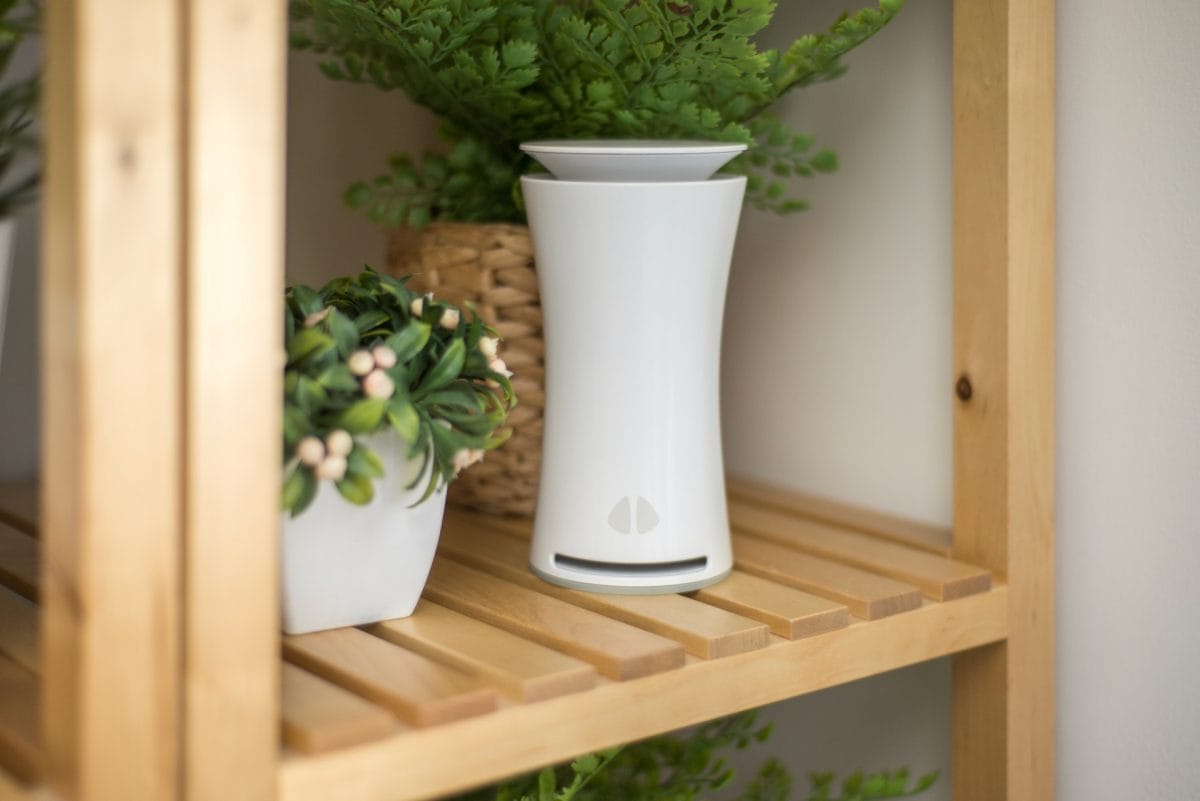

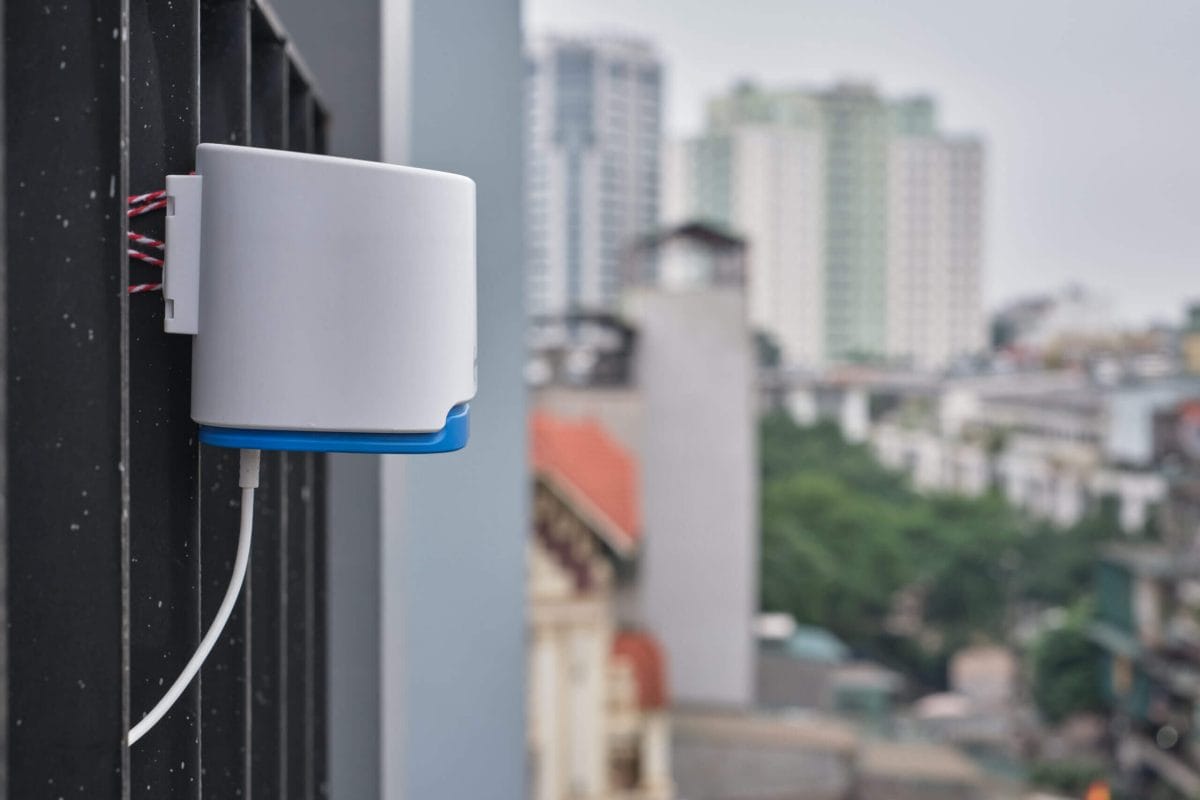
You’ve listed CO2 instead of VOC for the Atmotube Pro sensors
Thank you for pointing this out. It’s fixed now!
I bought the Temtop m10i, and its accuracy is through the floor. RIght now Acuweather and PurpleAir say our AQi is about 30 and PM2.5 is 8. Yet when I take this unit outside for awhile it doesn’t change, it reads AQi at 76 and PM2.5 as 25. These units are pretty much worthless if their accuracy is that bad. AQI of 30 is in the green, but 76 is yellow verging on orange. When I say review touting this unit, it makes me wonder if the others being shown are any better. I have my doubts about the whole list when I see Temptop m10 being shown as a good device.
Hi Timothy,
I don’t have the Temptop M10 on my list and I’ve never used it before – are you confusing it with another list?
Hi Ethan,
Can you comment on the PurpleAir PA-II unit relative to the uHoo? When I look at the below, for example, it seems to suggest the PurpleAir unit accuracy is pretty good and they don’t have much for the uHoo.
Thanks for the write up, super helpful!
Brandon
Thanks for the tip about how there are also smart devices that I could use when planning to be more vigilant about indoor air quality monitoring. I’d like to find an expert on that because I’ve been suffering from hay fevers more frequently. I’d like to put a stop to that as soon as possible.
I am also interested in the purple air sensors. Are there any plans to test these? Thanks for your research and testing!
Hi Ethan, great site, a really useful resource in understanding air quality better.
Something I haven’t read you talk about is what action you can take if air quality drops. When outside, what do you do, run for cover? I’m guessing, as you have little control of the environment, you put a mask on, or step inside. Inside, I can only think to filter out bad air using some kind of air purifier. In which case, these all come with various sensors that usually turn on or off the device automatically when needed. So not only do they monitor your air quality but also remedy it, without intervention, in one device. Maybe some reviews of the best purifiers would be helpful in future.
I’m just struggling to understand the benefit of a dedicated air quality sensor. Wonder if you could tell us in practical terms how you actually use them on a daily basis, rather than potentially just increasing awareness, and anxiety 🙂
Dear Mike,
Thank you for your kind words and for bringing up such an important aspect of air quality management. Your curiosity about actionable steps is spot on – awareness is only the first step, and taking action is crucial.
When outside, indeed, our control over the air quality is limited. If I find myself in an area with poor air quality, using a mask is one of the most immediate actions I can take, especially if the pollution is due to particulate matter, like PM2.5. A high-quality mask with a good seal can filter out the majority of harmful particles. Additionally, planning outdoor activities when pollution levels are lower, often in the morning or after a rain, is another practical approach.
For indoor air quality, as you’ve rightly mentioned, air purifiers are the go-to solution. They can actively remove pollutants from the air, and many modern units come with built-in sensors to adjust their operation based on the current air quality, making them user-friendly and efficient. However, these sensors are very often inaccurate or only measure one particle type (typically PM2.5) leaving a lot of room for improvement with a dedicated air quality sensor.
Regarding the utility of dedicated air quality sensors – they offer several practical benefits. They provide detailed information on various pollutants, not just particulate matter, which can inform your decisions. For example, if a sensor detects high levels of CO2, this indicates poor ventilation, prompting you to open a window or run an exhaust fan. If you’re someone with sensitivities or respiratory conditions, having real-time data can be invaluable for managing your health.
Furthermore, a dedicated sensor can serve as a benchmark to calibrate other devices, ensuring your purifiers and other smart home systems are functioning optimally. On a daily basis, I use my monitors to check the efficacy of my air purifiers, to decide the best times to ventilate, and to monitor for any unexpected changes in air quality, such as those that might come from a gas leak or an increase in humidity that could lead to mold growth.
Your suggestion for reviews of air purifiers is well-taken, and I believe it could complement the discussions about air quality monitors wonderfully. I’ll certainly consider adding comprehensive reviews to the site.
In short, while air quality sensors may seem like passive devices, they are, in fact, pivotal in informing the active steps we take to ensure the air we breathe is as clean as possible. I hope this clarifies their practicality, and I look forward to providing more insights and reviews that can help us breathe safer air.
Best regards,
Ethan
Thanks for your detailed and nice presentation of different air quality monitors. I’m wondering if you have missed to include Airthings products such View Plus & Wave Plus or you didn’t due to non existence of their product within your region maybe?
those products i mentioned are the most expensive and comprehensive on Airthings product list but for sure they have some other models with less than features and cheaper than other.
Below links to view & wave.
https://www.amazon.se/-/en/Airthings-2960-View-Plus-Notifications/dp/B097YW5Q72/ref=sr_1_2?crid=3J0K72857NYB7&keywords=airthings%2Bview%2Bplus&qid=1704466235&sprefix=aitthings%2Bview%2Bplus%2Caps%2C113&sr=8-2&th=1
https://www.amazon.se/-/en/Airthings-2930-Smart-Detector-Temperature/dp/B07JB8QWH6/ref=sr_1_3?crid=323QZ6EIO67AS&keywords=airthings+wave+plus&qid=1704466266&sprefix=airthings+wave+plus%2Caps%2C128&sr=8-3
Hi Ahmed,
These have been on my radar for a while now, but I, unfortunately, haven’t yet been able to get my hands on them. I am hoping to be able to add them to the site soon!
hello Ethan,
thanks for all the great info. I have a particular interest in measuring mould particles (which I believe are PM10?). Do any of your reviews cover devices (esp. portable) that directly measure PM10?
thanks, Sandra
Hi Sandra,
Most of the devices in this article that monitor PM include PM10. Any of those should work for your needs! They all also have temperature and RH sensors that will be helpful in identifying mould and the conditions it grows in.